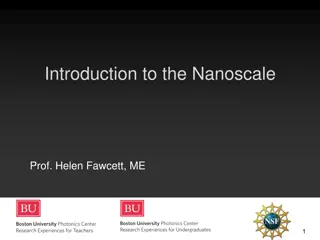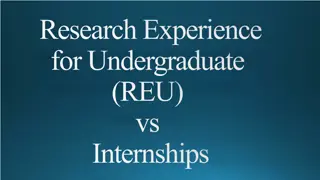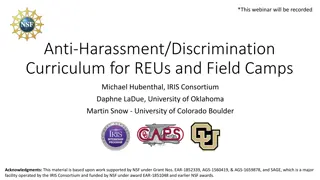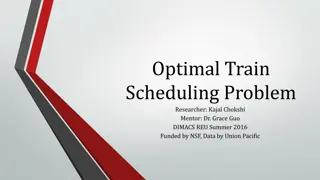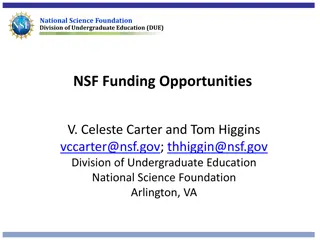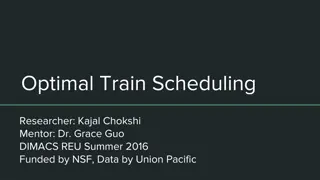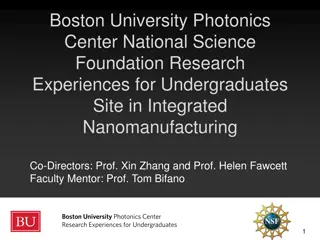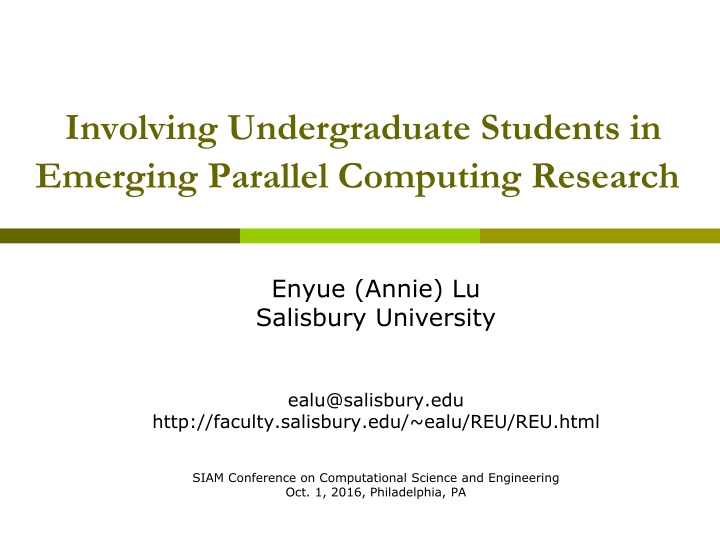
Involving Undergraduate Students in Emerging Parallel Computing Research
Explore how Salisbury University engages undergraduate students in parallel computing research through an NSF-funded REU program. Learn about motivations, challenges, and organizational partnerships shaping this innovative endeavor.
Download Presentation

Please find below an Image/Link to download the presentation.
The content on the website is provided AS IS for your information and personal use only. It may not be sold, licensed, or shared on other websites without obtaining consent from the author. If you encounter any issues during the download, it is possible that the publisher has removed the file from their server.
You are allowed to download the files provided on this website for personal or commercial use, subject to the condition that they are used lawfully. All files are the property of their respective owners.
The content on the website is provided AS IS for your information and personal use only. It may not be sold, licensed, or shared on other websites without obtaining consent from the author.
E N D
Presentation Transcript
Involving Undergraduate Students in Emerging Parallel Computing Research Enyue (Annie) Lu Salisbury University ealu@salisbury.edu http://faculty.salisbury.edu/~ealu/REU/REU.html SIAM Conference on Computational Science and Engineering Oct. 1, 2016, Philadelphia, PA
Introduction Research Experiences for Undergraduates (REU) Site: EXERCISE -Explore Emerging Computing in Science and Engineering Funded by NSF (CCF-1156509, CCF-1460900), Apr. 2012-Mar. 2015 (first funded) Feb. 2015-Jan. 2018 (renewed) Total 54 (=3*8+3*10) students across nation Ten-week summer undergraduate research program An interdisciplinary project that explores emerging paradigms in parallel computing with data and compute- intensive applications in science and engineering 2
Motivations The computing systems that employ the parallel processing paradigm will become a mainstream in the foreseeable future. Parallel computing is rarely taught and offered as research topics at undergraduate level. 3
Challenges Research Environment: Host site is a primarily undergraduate institution Limited research facilities Less number of research mentors Research Subject: Parallel Computing High cost and maintaining expense of massively parallel systems the complexity of parallel programming 4
Challenge I: Research Environment Host school: Salisbury University (SU) is a primarily undergraduate institution (PUI) located on the Eastern Shore of Maryland on the Delmarva Peninsula, an underdeveloped rural area The CS division in Math & CS Dept. at SU Research facilities: one research lab Research mentors: 6.5 CS faculty 5
Organizational partners University of Maryland Eastern Shore (UMES) UMES is a historically black land-grant institution located in the Delmarva Peninsula The UMES Engineering Program is the only engineering program on the Eastern Shore of Maryland Professors Yuanwei Jin and Lei Zhang at UMES serve as faculty mentor for REU research program. They oversee HBCU or minority student's applications and selection UMES provides REU students and faculty the access to Signal Processing and Intelligent Sensing (SPIS) Lab 6
Organizational partners University of Maryland College Park Dr. William Gasarch, Program Director of REU site CAAR: Combinatorial Algorithms-Applied Research University of Maryland Baltimore County Dr. Matthias Gobbert, Program Director of HPC REU site UMBC High Performance Computing Facility Johns Hopkins University Dr. Randal Burns, Hopkins Storage Systems Lab and Institute for Data Intensive Engineering and Science 7
Institutional commitment The Mathematics and Computer Science Department of SU has reserved Computer Science Undergraduate Research Lab (HS101) for the REU site every summer The Geography and Geosciences Department of SU shares GIS software with the REU site 8
Interdisciplinary faculty team PI, Dr. Enyue (Annie) Lu, Associate Professor of Computer Science at SU Dr. Steven Lauterburg, Assistant Professor of Computer Science at SU Dr. Arthur Lembo, Associate Professor of Geography and Geosciences at SU and Technical Director of the Eastern Shore Regional GIS Dr. Yuanwei Jin, Associate Professor of electrical engineering and Department Chair of Engineering and Aviation Sciences Department at UMES Dr. Lei Zhang, Assistant Professor of computer engineering at UMES 9
Interdisciplinary faculty team Dr. Randal Burns, Associate Professor of Computer Science, Director of Hopkins Storage Systems Lab (HSSL), and Affiliated Faculty of Institute for Data Intensive Engineering and Science (IDIES) at JHU Dr. Yaohang Li, Associate Professor of Computer Science at Old Dominion University 10
Challenge II: Research Subject The subject of parallel computing is typically taught at the graduate level and most PUIs do not offer any parallel computing course the cost and maintaining expense of massively parallel systems the complexity of parallel programming 11
Selected emerging paradigms in parallel computing Emerging paradigms in parallel computing are starting to demonstrate the power of solving problems with large data sets and high computational complexity GPU computing MapReduce computing 12
Graphics Processing Unit (GPU) computing Low-cost, low-power, very high performance alternative to conventional microprocessors an order of magnitude faster than CPUs It enables dramatic increases in computing performance by harnessing the power of the GPUs cheap and available video cards With CUDA (a parallel computing platform and programming model invented by NVIDIA), you can send C, C++ and Fortran code straight to GPU minimum learning curve 13
Sample projects using GPUs GPU Accelerated Ultrasonic Medical Tomographic Imaging Parallelizing Raster-Based Data in GIS with CUDA C GPU Factoring for Public-Key Cryptography Real Time Ray Tracing using GPU Computing 14
MapReduce computing Distributed parallel processing system using a large number of computers (nodes) in the Internet (cloud) Can be applied to solve large-scale computing problems Using the open-source Hadoop implementation The MapReduce cloud computing model consists of two phases. Amazon EC2 services 15
Sample projects using MapReduce Analyzing Patterns in Social Networks using MapReduce in Hadoop Clustering Algorithms for Large-Scale Graphs Using MapReduce Graph-Based Anomaly Detection using MapReduce on Network Records Distributed Graph-Based Clustering for Network Intrusion Detection 16
Selected applications for parallel computing computer networks and security Analyzing Patterns in Social Networks using MapReduce in Hadoop Distributed Graph-Based Clustering for Network Intrusion Detection GPU Factoring for Public-Key Cryptography Image and signal processing GPU Accelerated Ultrasonic Medical Tomographic Imaging Computer Graphics Real Time Ray Tracing using GPU Computing Geographic information system Parallelizing Raster-Based Data in GIS with CUDA C 17
Highlighted results The REU students presented their research in regional, national and international conferences IEEE/ACM Super Computing SPIE Conference on Computational Imaging Grace Hopper Celebration of Women in Computing Council on Undergraduate Research (CUR) s Research Experiences for Undergraduates Symposium National Conference on Undergraduate Research Maryland STEM Festival SU Henson Summer Research Symposium SU Annual Student Research Conference 18
Highlighted results The REU students are accepted by top graduate schools Carnegie Mellon University University of Illinois at Urbana-Champaign University of Virginia University of Tennessee, Knoxville One REU student was awarded as a Siebel Scholar. The EXERCISE project won the fourth place in the NSF REU highlight contest award among 69 CISE REU sites in 2012. 19
Questions? http://faculty.salisbury.edu/~ealu/REU/REU.html


